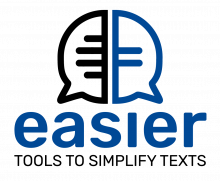2021
RTVE's programme "En Lengua de Signos" echoes the 10th AMADIS Congress on accessibility in the audiovisual media.
You can watch the programme at https://www.rtve.es/play/videos/en-lengua-de-signos/24-10-21/6152700/
Desde septiembre de 2021 y con una duración de 3 años, en el grupo HULAT vamos a trabajar en el proyecto “Accesibilidad cognitiva y sensorial a los sistemas de videoconferencia (Access2Meet)” (PID2020-116527RB-I00, Programa Estatal de I+D+i Orientada a los Retos de la Sociedad).
The HULAT group collaborates in the organisation of the 10th Edition of the AMADIS Congress
In the HULAT group, we launch a new project. Project “Cognitive and sensory accessibility to video conferencing systems (ACCESS2MEET)" , Convocatoria 2020 Proyectos Generación del Conocimiento y Retos Investigación.
From September 22 to 24, the Spanish Computer Science Conference (CEDI 20/21), will be held in Malaga. HULAT group will participate in different conferences within CEDI 20/21.
We will participate in the First Workshop on Current Trends in Text Simplification (CTTS-2021) within the Spanish Society for Natural Language Processing (SEPLN 2021) conference; Rodrigo Alarcon will present the work “Exploration of Spanish Word Embeddings for Lexical Simplification steps”. In addition, the work “Designing and Evaluating a User Interface for People with Cognitive Disabilities” will be presented at the International Human-Computer Interaction (Interaction 20/21) conference.

People with intellectual, language and learning disabilities face accessibility barriers when reading texts with complex words. To offer support to these reading aids, a lexical simplification system for Spanish has been developed and is presented in this article. The system covers the complex word identification task and offers replacement candidates with the substitute generation and selection task. These tasks have followed machine learning techniques and contextual embeddings using Easy Reading and Plain Language resources, such as dictionaries and corpora. These findings represent an additional advancement in the lexical simplification of texts in Spanish and in a generic domain using easy-to-read resources. The article is by Rodrigo Alarcon, Lourdes Moreno and Paloma Martínez from the HULAT group in the EASIER project.

Entrevista de radio en "Hoy por Hoy" de la SER a Lourdes Moreno del grupo HULAT por el proyecto EASIER, un sistema de simplificación léxica en español para hacer la información accesible a las personas con discapacidad intelectual financiado por INDRA y Fundación Universa. En este proyecto se han utilizado técnicas de accesibilidad y de Procesamiento de Lenguaje Natural.

EASIER es una plataforma que ayuda a las personas a comprender mejor los textos y funciona apoyándose en métodos de inteligencia artificial. Básicamente proporciona simplificación léxica de los textos en español ofreciendo distintas ayudas a la comprensión.
 People with intellectual, language and learning disabilities face accessibility barriers when reading texts with complex words. To offer support to these reading aids, a lexical simplification system for Spanish has been developed and is presented in this article. The system covers the complex word identification task and offers replacement candidates with the substitute generation and selection task. These tasks have followed machine learning techniques and contextual embeddings using Easy Reading and Plain Language resources, such as dictionaries and corpora. These findings represent an additional advancement in the lexical simplification of texts in Spanish and in a generic domain using easy-to-read resources. The article is by Rodrigo Alarcon, Lourdes Moreno and Paloma Martínez from the HULAT group in the EASIER project.
People with intellectual, language and learning disabilities face accessibility barriers when reading texts with complex words. To offer support to these reading aids, a lexical simplification system for Spanish has been developed and is presented in this article. The system covers the complex word identification task and offers replacement candidates with the substitute generation and selection task. These tasks have followed machine learning techniques and contextual embeddings using Easy Reading and Plain Language resources, such as dictionaries and corpora. These findings represent an additional advancement in the lexical simplification of texts in Spanish and in a generic domain using easy-to-read resources. The article is by Rodrigo Alarcon, Lourdes Moreno and Paloma Martínez from the HULAT group in the EASIER project.
 Entrevista de radio en "Hoy por Hoy" de la SER a Lourdes Moreno del grupo HULAT por el proyecto EASIER, un sistema de simplificación léxica en español para hacer la información accesible a las personas con discapacidad intelectual financiado por INDRA y Fundación Universa. En este proyecto se han utilizado técnicas de accesibilidad y de Procesamiento de Lenguaje Natural.
Entrevista de radio en "Hoy por Hoy" de la SER a Lourdes Moreno del grupo HULAT por el proyecto EASIER, un sistema de simplificación léxica en español para hacer la información accesible a las personas con discapacidad intelectual financiado por INDRA y Fundación Universa. En este proyecto se han utilizado técnicas de accesibilidad y de Procesamiento de Lenguaje Natural.
 EASIER es una plataforma que ayuda a las personas a comprender mejor los textos y funciona apoyándose en métodos de inteligencia artificial. Básicamente proporciona simplificación léxica de los textos en español ofreciendo distintas ayudas a la comprensión.
EASIER es una plataforma que ayuda a las personas a comprender mejor los textos y funciona apoyándose en métodos de inteligencia artificial. Básicamente proporciona simplificación léxica de los textos en español ofreciendo distintas ayudas a la comprensión.
